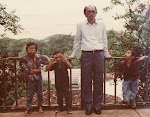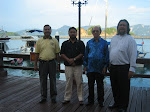What is Hamas?
The Muslim Brotherhood was founded in 1928 in Egypt and for many years was one of the principal Islamic revivalist movements in the Middle East. They were primarily a social and religious group, although in Egypt four of their members were the assassins who killed President Anwar Sadat for his peace treaty with Israel. Then in 1987, after years of concentrating on social and educational activity in the Palestinian Arab areas, the Muslim Brotherhood was confronted with fundamental challenges in the wake of the intifada in Gaza and the West Bank. As the uprising became the main focus of the Palestinian Arab population, the Muslim Brotherhood's leaders found themselves detached from the events which were being led by Islamic Jihad and the PLO from their headquarters in exile in Tunisia. Their response was a new organization, founded December 14, 1987 at the beginning of the intifada: Hamas (Harakat Muqawama Islamiyya — the Islamic Resistance Movement). The Hamas Covenant was drawn up in 1988, explaining the organization's Islamic ideological sources, its ideas on the Israeli-Palestinian conflict, its approach as a Muslim-Palestinian movement, and its attitude toward the PLO.
Hamas recognized the contributions of the PLO in creating the idea of a Palestinian nation and in leading the political and military struggle against Israel. But Hamas did not regard the PLO as superior or primary in representing the Palestinian Arabs, especially regarding Islam. For Hamas, the one true path to liberate the land is armed struggle, jihad, and negotiations with Israel have no role. The Hamas Covenant says it plainly:
- There is no other solution for the Palestinian problem other than jihad. All the initiatives and international conferences are a waste of time and a futile game.
Hamas offers believers a clear vision of a Palestinian state from the Mediterranean Sea to the Jordan River, its way of life grounded in the values and principles of Islam. This is in contrast to the picture of the future illustrated by the PLO: a small, shrunken state, of indeterminate character. Hamas uses antiquated European anti-Semitic terminology to describe the Jews and Israel and expects to fully eliminate them from the Middle East by violent means.
PLO support for Iraq in the 1990 Gulf crisis had a positive impact on Hamas' relations with Saudi Arabia, which resulted in immediate economic benefits. Hamas' position on the crisis was considered more balanced than the PLO's, mainly because the movement's leaders had always been critical of the secular Iraqi regime. The PLO, on the other hand, unequivocally sided with Iraq. Thus, Saudi Arabia increased its financial aid to Hamas, via religious institutions and mosques, in order to punish the PLO.
After the Gulf War and the start of the Oslo peace process, the PLO was further distanced from Hamas. As part of its efforts to encourage radical Islamic movements and reinforce opposition to the PLO, Iran gave its support to Hamas. According to Palestinian sources (denied by Hamas), the Iranians pledged $30 million a year to Hamas, and agreed to train thousands of Hamas activists in Iran and in Hizballah camps in Lebanon. The PLO was sharply critical of the agreement which also left open the possibility of Hamas extending its struggle into southern Lebanon through operational cooperation with Hizballah. Israel's expulsion of hundreds of Hamas activists to southern Lebanon in 1992 only increased the solidarity between Hamas and Hizballah.
During 1993 there was a temporary improvement in relations between the PLO and Hamas as the PLO suspended peace talks with Israel over a crackdown on Palestinian terrorists, including Hamas. But after the signing of the Oslo Agreement in September 1993, Hamas increased its terrorist activities, again in competition with the PLO. At that point, Arafat and his Palestinian Authority were obligated to end terrorism and incitement against Israel as a condition of Israel's acceptance of its obligations, in opposition to Hamas and all other terrorist groups.
Hamas' strategic goal was acquiring dominance in Palestinian politics, under the banner of Islam. With the PLO making strides through peace process negotiations in 1993-1995, and morphing into the Palistinian Authority with elections in January 1996, Hamas again found itself out of the mainstream. Their choices were bleak: to join in the negotiations would be a break with their origins and philosophy, but to continue to oppose the Oslo process made them dangerously irrelevant to the emerging Palestinian Arab state. Hamas struggled internally to find the proper course while cooperation developed between Hamas and the PA so as to avoid intra-Palestinian fighting. After a violent incident between Fatah and Hamas in 1994, and severe reactions from Israel to Hamas-instigated terrorism, a series of agreements was worked out between Hamas and the PA that solved the problem for both organizations. Arafat and the PA learned to ignore Hamas terrorism in exchange for Hamas refraining from challenging their political leadership of the Palestinians. By the end of the 1990s, the rivalry between Hamas and the PLO/PA had become a collaboration. Hamas terrorist operations gave Arafat leverage in negotiations and allowed him to appear moderate compared to the alternative. In turn, the PA gave Hamas cover from the Israelis -- when the occasional crackdown was necessary, the PA would put Hamas operatives into a revolving-door jail, keeping them from Israeli justice.
In 1997, Arafat personally presided over a memorial rally for "the martyred fighter, Salah al-Qidwa," in Gaza on November 3. PLO Executive Committee member Zakaria al-Agha, speaking at the rally on behalf of Arafat, declared "we still remember the martyrs and still follow their path." Amad Hils, Secretary-General of the Higher Committee of Arafat's Fatah movement, told the rally that Yiyhe Ayyash (the Hamas bomb-maker who killed at least 60 Israelis) and Imad Aql (the first commander of Hamas's military wing) were "holy martyrs."
With the outbreak of the al-Aqsa intifada in September 2000, Hamas, along with other groups opposing Israel such as Islamic Jihand, began to work in parallel with PA security forces directly controlled by Arafat. Any pretense that Arafat's PA had the terrorists under control or that there was an ongoing peace process was dropped.
On March 21, 2004 Israeli helicoptor gun ships killed Hamas founder and spiritual leader Sheik Ahmed Yassin. Yasser Arafat declared 3 days of mourning and praised Yassin. "This is one of the biggest crimes that the Israeli government has committed," said Ahmed Qureia, prime minister of the Palestinian Authority.
Yassin was immediately replaced by Abdel Aziz Rantisi, a 54-year-old pediatrician who escaped an Israeli assassination attempt in June of 2003. Rantisi was a hard-liner, on record as opposed to even a temporary truce with Israel. Rantisi declared himself to be Yassin's successor without waiting for any formal process by the Hamas leadership. On April 17, 2004 Rantisi was killed in Gaza by Israeli anti-terrorism forces, a few hours after an Israeli Border Policeman was killed and three other Israelis were wounded in a suicide bombing at the Erez Crossing in Gaza, a bombing Hamas jointly claimed with Fatah.
(From Hamas 6 Januari 2009)











.jpg)



.jpg)





.jpg)
.jpg)
.jpg)
.jpg)
.jpg)
.jpg)
.jpg)










































No comments:
Post a Comment